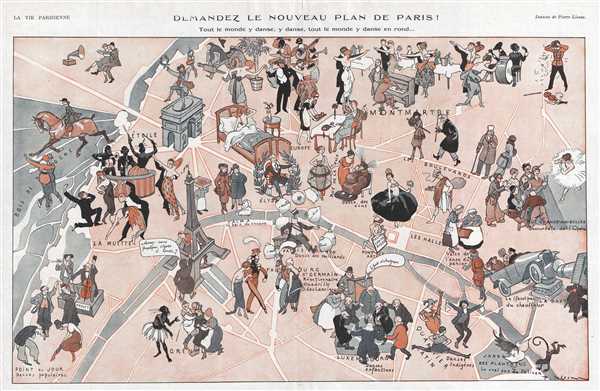This is a 1920 Pierre-Marie-Joseph Lissac pictorial map of Paris, France. The map depicts the city from the Bois de Boulogne to the Jardin des Plantes and the 'Rue Grange-aux-Belles' and from Montmartre to the Jardin du Luxembourg. A satirical look at Jazz Age Paris, the map emphasizes the gaiety of life in Paris following the end of World War I. Very few buildings are illustrated, only the Arc de Triomphe at Etoile and the Eiffel Tower. The rest of the map is populated by Parisians or visitors. Everyone is either dancing or otherwise taking advantage of the pleasures of life in Paris. People are either partaking, or watching those who are. Even the animals in the menagerie in the Jardin des Plantes are dancing. However, there is some biting commentary as well. Several dances are labeled, which are not truly dances at all. The danse des milliards (dance of the millionaires) and the valse de l'anse du panier (waltz of the basket handle), for example. The excesses of the time are also made apparent through one man’s question of whether or not there is 'something to rent' in the Eiffel Tower. Another important detail worth noting is the depiction of black entertainers. Drawn more as a caricature than any of the white Parisians, this is not a strange occurrence for the time period. Advertisements, particularly for items that originated in the Colonies, would often depict Africans in such a manner. Here, they are illustrated as playing in a band and, apparently, as an entertainer in the southern part of the city.
As far as Parisian geography is concerned, the Seine still traverses the city, and several neighborhoods are labeled, including Les Halles, Faubourg Saint Germain, La Muette, and, of course, Montmartre. Numerous streets are illustrated, although none are labeled.
This map was produced by Pierre-Marie-Joseph Lissac and published in the February 14, 1920 issue of La Vie Parisienne.
Cartographer
Pierre-Marie-Joseph Lissac (March 19, 1878 – 1955) was a French painter, illustrator, and engraver who was also known as a caricaturist under the names 'Pierlis' and 'Kiss'. Born in Limoges, Lissac was admitted to the School of Fine Arts in Paris in 1897. By the 1910s, Lissac had become an important contributor to various humor magazines in France, such as L'assiette au beurre, Le Rire, La Vie Parisienne and several others. Between 1924 and 1950, Lissac produced a large amount of work, including collaborations with contemporary authors, illustrated children’s books, and numerous advertisements. As a member of the Societe nationale des beaux-arts, Lissac exhibited paintings at several salons and during the 1937 Universal Exposition in Paris. During World War II, Lissac managed to escape to Morocco and established a studio in Rabat. While there, he produced watercolor paintings with eastern themes, mostly landscapes and street scenes. More by this mapmaker...
Source
La Vie Parisienne, February 14, 1920.
La Vie Parisienne (1863 – 1970) was an illustrated French culture magazine that also supplied the name for the celebrated Jacques Offenbach opera La Vie parisienne. The expression vie parisienne began being used during the Bourbon restoration, but gained popular use following the publication of Honore de Balzac’s novel titled Scenes de la vie p-parisienne in 1834. The magazine’s founder, Marcelin, wanted to take advantage of the popularity of the phrase when he decided to found a magazine. The subtitle for La Vie parisienne was: 'Moeurs elegantes, Choses du jour, Fantaisies, Voyages, Theatres, Musique, Modes' (Elegant traditions, Things of the day, Fantasies, Travels, Theatre, Music, Fashion). A weekly magazine, La Vie parisienne helped to liberalize and diversify the press. By 1905, due to a lessening in censorship, La Vie parisienne began to publish more and more erotic imagery. This publication was very popular among the soldiers in the trenches during World War I, even publishing requests for ‘wartime godmothers’, which also translates as pen pals. By the 1930s, cinema had become a major part of the publication, and by the 1940s, pin-ups began making regular appearances.
Very good. Text on verso.


